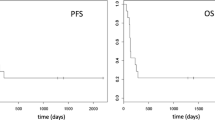trans
retinoic acid (45 mg/m2) and s.c. low-dose cytosine arabinoside (LDARAc) given at the dose of 20 mg twice per day. The courses were repeated monthly until response or progression; in the case of response, the therapy was administered until relapse. Morphologic diagnoses were refractory anemia with excess blasts (RAEB) in nine, RAEB in transformation (RAEB-t) in nine, and chronic myelomonocytic leukemia (CMMoL) in four patients; in all cases, bone-marrow blast infiltration was greater than 10% (median 20%, range 12–30%). When the international prognostic scoring system was applied, all the cases qualified as intermediate/high-risk categories. Nineteen patients were males and three were females; the median age was 69 years (range 25–90 years); three patients had previously been treated with conventional chemotherapy, and one of them had also undergone autologous bone-marrow transplantation. The criteria of response were defined as follows: (1) complete response: normalization of blood counts and bone-marrow blasts ( <5%), and (2) partial response: decrease in bone-marrow blast infiltration by 50%, and two of the following parameters – improvement in hemoglobin level by 1.5 g/dl or decrease by 50% in transfusional requirement, increase by 50% in absolute neutrophil count, and increase by 50% in platelet count. Overall, 7 (32%) of 22 patients achieved a response, with 5 (23%) being classified as complete responders and 2 (9%) as partial responders. Fifteen (68%) patients did not achieve any response, and 14 died of progressive disease or infectious disease. The overall median survival was 8 months (range 1–27 months), whereas the median survival of responders was 16 months (range 8–27 months); the median duration of response was 11 months (range 2–21 months). Moderate to severe hematological toxicity and infections were the most common side effects. In conclusion, it seems that the association of ATRA and LDARA-C may be effective in approximately 30% of HRMDS patients. Optimizing this approach might be pursued by selecting, on a biological basis, those cases more likely to respond or by incorporating other differentiating agents or growth factors.
Similar content being viewed by others
Author information
Authors and Affiliations
Additional information
Received: 20 August 1999 / Accepted: 25 October 1999
Rights and permissions
About this article
Cite this article
Venditti, A., Tamburini, A., Buccisano, F. et al. A phase-II trial of all trans retinoic acid and low-dose cytosine arabinoside for the treatment of high-risk myelodysplastic syndromes. Ann Hematol 79, 138–142 (2000). https://doi.org/10.1007/s002770050569
Issue Date:
DOI: https://doi.org/10.1007/s002770050569




